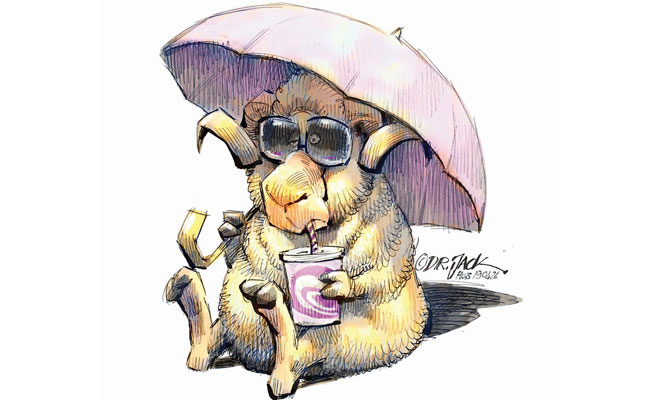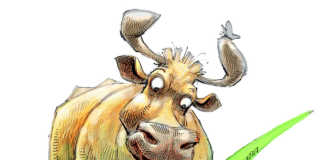
The potential contributions of climate-smart animal agriculture to society are almost unlimited.
Animal agriculture would be climate-smart if adaptability of indigenous breeds were fully exploited.
This applies more to resource-poor systems, however; in input-intensive systems, the approach would be different. Either way, there is an urgent need to alleviate the negative effects of climate change on livestock production to meet growing demand for livestock products worldwide.
Climate change requires extension services, researchers and trainers to collaborate and upgrade their skills in order to keep pace with ever-changing sector norms. These services in sub-Saharan Africa often operate in silos, although they serve the same farmers.
For better results, services must be integrated and involve all stakeholders, including public, private and non-government sectors, industry value chains, and educational institutions at a local, national and international level.
This is because climate change has local and global implications, as greenhouse gasses (GHGs) emitted in one country can influence production in another, and over- or underproduction of a commodity in one place affects commodity prices on the global market.
Competitive advantages
Climate-smart agriculture (CSA) is sustainable farming that meets the need for safe and adequate food and fibre while preserving the integrity of ecosystems, and does so by maximising the net benefit to society when all costs and benefits are considered.
Climate-smart livestock production is guided by the animal’s genotype within its environment; this exploits the animal’s inherent competitive production advantage in the environment, and is ‘in sync’ with Charles Darwin’s theory of evolution that ‘a grain in the balance will determine which individual shall live and which shall die’.
Darwin’s theory implies inherent competitive advantage of survivors over those who have succumbed in a given environment.
The environment is the sum total of factors that influence production in that habitat; these include nutrition, genetics, disease, exposure to parasites, management practices, climate, rainfall, humidity, heat and cold stressors, advisory services, and the skill of farmers. An animal’s phenotype results from interaction of its genotype and the environment.
In the past, human migrations transferred livestock breeds from places of origin to distant zones, where some have no inherent competitive advantage. For example, crossbreeds of B. taurus and B. indicus have higher average performance than the median of parent populations. However, this heterotic effect of hybrids is associated with loss of environmental adaptation, in contrast to parent populations. The loss of adaptive capacity by hybrids requires habitat modifications for these animals to express their fullest genetic potential.
Choosing a breed
Indigenous African breeds thrive with minimum input costs, in contrast to imported breeds. They are pivotal in climate-smart livestock production, especially in communal and small-scale farming systems.
Animals from temperate environments cannot express their fullest genetic potential in Africa without costly environmental modifications.
Quality of veld is linked to quantity and distribution of rainfall, and to seasonal variation of the natural pasture feed base.
Some indigenous breeds become browsers in periods of scarce grass. Livestock production on natural pasture does not use extra water for cultivated pastures, and lowers the water and carbon footprints of products from such systems.
Each of the 150 or so B. taurus and B. indicus African cattle breeds is adapted to its environment through centuries of natural selection. In contrast, temperate breeds selected for meat and milk must acclimatise in order to be productive. It is therefore prudent to exploit the inherent competitive advantages of indigenous genotypes and mitigate climate change.
Climate change challenges livestock production by providing conditions favourable for heat stress, which causes behavioural, chemical, physical, nutritional, physiological and metabolic responses as the animal’s physiology strives to preserve cell integrity for survival.
Moreover, the increase in human activity-related GHGs is raising average temperatures, which may lead to vegetation shifts, where nutritious plants could eventually be replaced by desert-adapted, woody plants whose stomata remain shut during the day to reduce evapotranspiration, but open at night to collect carbon dioxide.
Such changes in grass species composition erode the feed base. Its replacement by less digestible forages with a higher methane conversion rate can increase GHG emissions.
The ability to convert grass, shrubs and foliage into food and fibre is the reason ruminants occupy 45% of the world’s ice-free land area. Between 7% and 18% of human-induced GHGs come from livestock farming, specifically from enteric fermentation, manure, production and transport of feed, and change in land use.
Indeed, 65% to 75% of variable costs in livestock enterprises are ascribed to feed, and feed production accounts for 47% of the GHGs from livestock farming.
This is why animal nutrition is a pivotal area to mitigate climate change. Improving forage quality improves digestion and reduces enteric excretion of methane (CH4), which boosts feed efficiency.
Enteric CH4 mitigation interventions can be grouped into three categories: feeding and nutrient management; rumen modifiers; and genetic and management. Research produces technologies that improve production efficiency and results in less feed and water being consumed per unit product.
As far back as 1930, strong associations between enteric CH4 production and dry matter intake (DMI) in cattle fed temperate forages had been reported.
CH4 production is higher in cattle fed tropical forage diets, especially on higher intake, than in those fed temperate forages, becaue of the latter’s low digestibility. Improved forage quality will therefore lower the lifetime GHG emissions per unit product due to improved digestibility.
Nutrigenomics
Nutritional sciences and the development of technologies that allow in-depth study of gastrointestinal microbiome have created golden opportunities to manipulate rumen methanogens and reduce enteric CH4 excretion.
When enteric CH4 production can be reduced with no detriment to productivity, more feed energy is partitioned into intermediary metabolism for productive purposes and improves efficiency.
Enteric methanogenesis undermines efficient feed use and should be minimised to mitigate global warming without compromising rumen function.
Indeed, several technologies have been developed, including feed additives to enhance DMI and suppress acetate production and the amount of hydrogen released; ensiling forages at earlier regrowth stages to improve digestive efficiency and reduce GHG emissions, and grinding and pelleting forages before feeding lowers GHGs.
The emerging field of nutrigenomics looks at how feed-bioactive compounds affect the animal’s metabolism by altering gene expression. Nutrigenomics, which encompasses several disciplines, provides technologies that enable feeding according to genetic potential, ensuring precise nutrition.
Precision nutrition lowers GHG emissions and decreases the volume of excreta, which benefits both the climate and the environment.
Through nutrigenomics, gene expression can be controlled by dietary means at any point on the pathway from gene packaging and unpacking of DNA to protein processing and degradation. This enables optimisation of diets for livestock, in line with their genetic potential and physiological and production states.
More focus is also required on climate-smart breeding programmes using heat stress-tolerant genotypes with above-average production efficiency and low carbon and water footprints per unit product. Increasing efficiency is climate-smart.
The US Department of Agriculture calculates that, globally, the number of dairy cows decreased from 133 million to 125 million between 1997 and 2007, while milk production increased from 377 to 418 million tons. This demonstrates an 18% increase in milk production efficiency over the 10-year period.
Innovations to improve efficiency would go a long way towards ameliorating the effects of climate change and boost production of affordable, nutritious livestock products. – Roelof Bezuidenhout
The views expressed in our weekly opinion piece do not necessarily reflect those of Farmer’s Weekly.
Based on Kadzere, CT. 2018. ‘Environmentally smart animal agriculture and integrated advisory services ameliorate the negative effects of climate change on production.’ South African Journal of Animal Science. 48 (5).
Email [email protected].













